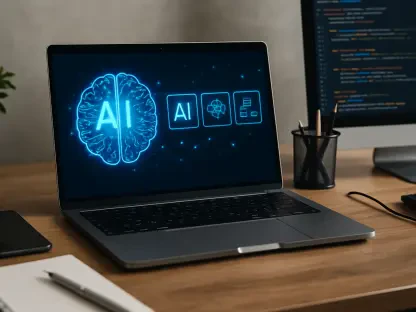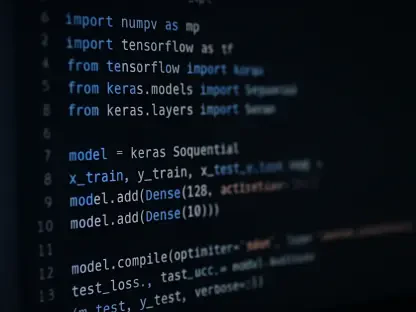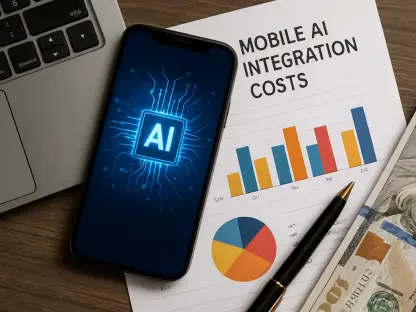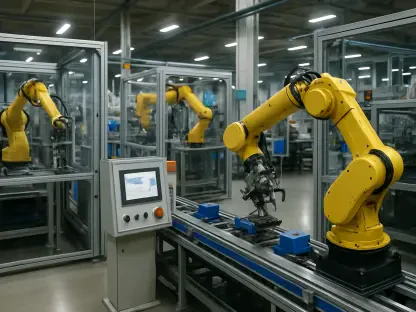Imagine a world where software developers spend less time on tedious coding tasks and more on crafting innovative solutions to complex problems, all thanks to the power of artificial intelligence. In today’s fast-paced tech landscape, AI is no longer just a futuristic concept but a tangible force reshaping how software is designed, built, and maintained. This review dives deep into the integration of AI in software development, exploring its transformative capabilities, real-world applications, and the hurdles that accompany its adoption. The aim is to provide a clear, balanced perspective on how this technology is revolutionizing the industry while highlighting areas that demand cautious navigation.
The Emergence of AI in Software Development
Artificial intelligence has swiftly become a cornerstone of modern software development, driven by its ability to streamline processes through machine learning and automation. At its core, AI leverages vast datasets to predict patterns, optimize workflows, and reduce human intervention in repetitive tasks. This integration is not merely a trend but a fundamental shift, as development teams across the globe adopt AI tools to stay ahead in an increasingly competitive field.
The relevance of AI in this domain lies in its capacity to enhance efficiency while fostering innovation. From startups to tech giants, organizations recognize that embedding AI into their workflows can significantly cut down project timelines and improve output quality. This growing reliance sets the stage for a deeper examination of how AI is applied in practical scenarios, pushing the boundaries of what developers can achieve.
Key Features of AI in Development Processes
Automation of Routine Tasks
One of the standout features of AI in software development is its ability to automate mundane, time-consuming tasks such as code generation and debugging. By utilizing sophisticated algorithms, AI tools can write boilerplate code or suggest fixes for common errors, often in real time. This not only accelerates the development cycle but also minimizes the likelihood of human oversight in intricate projects.
The performance of these tools is particularly notable in reducing error rates. AI systems, trained on extensive repositories of code, can identify inconsistencies or potential bugs that might be missed during manual reviews. This capability allows developers to redirect their focus toward more strategic aspects of their work, such as designing innovative features or solving unique challenges.
The significance of this automation extends beyond mere convenience. By handling repetitive elements, AI empowers teams to prioritize creativity and problem-solving, fundamentally altering the developer’s role from a task executor to a visionary thinker. This shift is proving to be a game-changer in maintaining high productivity levels across diverse projects.
Boosting Collaboration Among Teams
AI is also redefining how development teams collaborate, breaking down barriers through intelligent tools that analyze codebases and recommend optimizations. These systems can detect discrepancies in coding styles or suggest best practices, ensuring consistency across contributions from multiple developers. Such functionality fosters a unified approach without the need for constant oversight or lengthy discussions.
Another critical advantage is the democratization of expertise within teams. AI-driven platforms enable less experienced developers to produce high-quality work by offering real-time guidance and insights typically associated with veteran coders. This levels the playing field, allowing diverse teams to operate with a shared standard of excellence.
Moreover, AI enhances communication by providing data-driven insights into project progress. Tools equipped with predictive analytics can highlight potential bottlenecks, enabling team leads to make informed decisions swiftly. This collaborative edge is invaluable in maintaining momentum, especially in environments where deadlines are tight and precision is paramount.
Cutting-Edge Trends in AI-Driven Development
The landscape of AI in software development is continuously evolving, with recent advancements in machine learning models specifically tailored for coding tasks. These models are becoming more adept at understanding context, enabling them to generate more accurate and relevant code snippets. Such progress hints at a future where AI could handle increasingly complex programming challenges with minimal human input.
Concepts like ambient AI are also gaining traction, promising to automate entire development workflows from initial design to final deployment. This holistic approach could redefine efficiency, allowing for seamless integration across various stages of software creation. Industry experts anticipate that such innovations will become standard practice within the next few years, starting from now through 2027.
Additionally, there is a noticeable shift in industry behavior toward mandatory AI adoption. Companies that fail to incorporate these tools risk falling behind, as competitors leverage AI to deliver faster, more reliable solutions. This trend underscores the urgency for organizations to adapt, positioning AI as a critical component of maintaining market relevance.
Practical Implementations and Sector-Wide Impact
In real-world settings, AI is making a tangible difference across multiple industries, particularly in sectors like fintech and e-commerce. Here, AI-driven predictive analytics are used to enhance project management by forecasting potential delays or resource shortages based on historical data. This foresight ensures that projects adhere to strict timelines, a crucial factor in high-stakes environments.
Unique implementations also stand out, such as AI systems that optimize resource allocation during peak development phases. By analyzing workload distribution and team capacity, these tools help managers deploy talent effectively, minimizing burnout and maximizing output. Such applications demonstrate AI’s versatility in addressing both technical and logistical challenges.
The broader impact on the industry is evident in how AI is reshaping development priorities. With routine tasks automated, companies can allocate more resources to innovation, resulting in software that is not only functional but also groundbreaking. This shift is creating a ripple effect, pushing standards higher and encouraging a culture of continuous improvement across tech sectors.
Obstacles and Constraints in AI Adoption
Despite its many benefits, integrating AI into software development comes with significant challenges, starting with concerns over data privacy. AI tools often rely on vast amounts of sensitive data, raising questions about how this information is stored and protected. Organizations must establish stringent safeguards to prevent breaches that could compromise trust or compliance.
Another pressing issue is the reliability of AI-generated code, which can sometimes contain errors or introduce vulnerabilities if not thoroughly vetted. The accelerated pace of development enabled by AI can exacerbate this risk, often referred to as the speed trap, where haste undermines security. Rigorous testing protocols are essential to ensure that outputs meet quality standards without sacrificing safety.
Ethical considerations and resistance to change also pose hurdles. Developers may be wary of over-reliance on AI, fearing it could diminish the value of human judgment. Addressing this requires comprehensive training, clear ethical guidelines, and strong leadership to foster a culture where AI is seen as a complement rather than a replacement. Effective change management remains a cornerstone of successful integration.
Prospects for AI in Software Development
Looking ahead, the trajectory of AI in software development points toward groundbreaking possibilities, such as self-correcting software that can identify and resolve issues autonomously. This potential could drastically reduce maintenance overhead, allowing developers to focus on creating rather than fixing. The implications for efficiency and reliability are profound, promising a new era of resilient applications.
Full workflow automation is another anticipated milestone, where AI could oversee every phase of development with minimal human oversight. Such advancements would not only speed up delivery but also enhance the adaptability of software to changing requirements. This vision, while ambitious, is within reach as machine learning capabilities continue to mature.
The long-term impact on the competitive landscape cannot be overstated. AI is poised to become a defining factor in determining which companies lead and which lag behind in the tech industry. As adoption deepens, the focus will likely shift toward creating ecosystems where AI and human ingenuity coexist, driving innovation at an unprecedented scale.
Final Thoughts and Next Steps
Reflecting on this exploration, it becomes clear that AI has proven to be a transformative force in software development, automating repetitive tasks, enhancing team synergy, and enabling smarter project oversight. Challenges like data privacy, code reliability, and cultural resistance have presented notable obstacles, requiring careful navigation to unlock the full spectrum of benefits.
Moving forward, stakeholders should prioritize the development of robust security frameworks to address vulnerabilities introduced by rapid AI-driven processes. Investing in comprehensive training programs is also critical to ensure teams adapt effectively to these tools. Additionally, fostering industry-wide dialogue on ethical standards could help mitigate risks while promoting responsible innovation.
Ultimately, the journey with AI in software development underscores the need for a balanced approach, where speed does not compromise quality. By focusing on strategic implementation and continuous improvement, the industry can harness AI to build software that is not only efficient but also visionary, paving the way for future technological leaps.









